
White House chefs: 'Completely dedicated to the house'
9/18/2012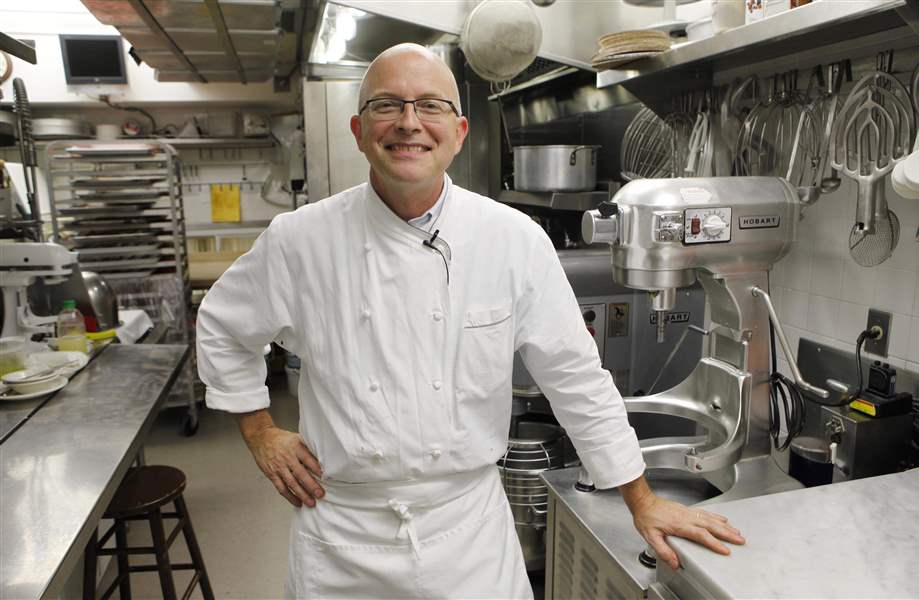
White House pastry chef Bill Yosses as he poses in his kitchen.
ASSOCIATED PRESS
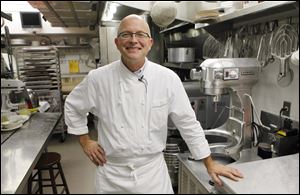
White House pastry chef Bill Yosses as he poses in his kitchen.
WASHINGTON -- It's the scandal no one is talking about. The scandal that will be ignored by history. The scandal that never once threatened to take down the presidency.
It's Rhubarbgate.
Word of the extremely minor brouhaha leaked out at the recent meeting of the Association of Food Journalists. A panel of White House chefs, past and present, were talking about the responsibilities that come with feeding the leader of the free world.
Bill Yosses, the current White House pastry chef and a native of Toledo, was singing the praises of the White House garden. The idea of the garden came from First Lady Michelle Obama as a way to encourage people to use fresh, sustainable, and local produce in their cooking. That is when Mr. Yosses' longtime predecessor, Roland Mesnier, spoke up.
Gardens at the White House are nothing new, he said, the staff always grew a portion of its own food. And then Mr. Mesnier, who has never been known to mince his words, went on to say he found it curious when he saw reports that 200 pounds of rhubarb had been cut from the garden in just one day.
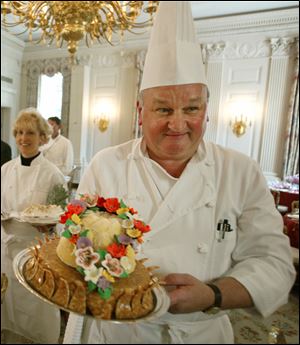
White House Pastry Chef Roland Mesnier
Rhubarb takes three or four years before it begins to produce at a high rate, he said, and the garden had only been installed for one year. So how was it possible for so much rhubarb to be picked?
It was Mr. Yosses who coined the term Rhubarbgate, with a laugh. The answer, he said, is that the garden often receives plantings, not fully grown, from area farmers to augment what the staff has been growing in the garden.
That is one secret revealed by the chefs, but others were not. Part of the job entails keeping strict silence about the personal lives of the presidents and their families, especially the children. The only nugget the journalists could pry from the chefs was that, according to Mr. Mesnier, Amy Carter used to come down to the kitchen to make cookies, and after she put them in the oven she would go off somewhere else, allowing the cookies to burn.
Christeta Comerford, the current executive chef -- she's the first woman and the first member of a minority group (she is Filipino) to hold the position -- said that the president's family pays for its own food out of its own pocket, and yes, they eat leftovers. But a state dinner is something different, she said, and not just because it is paid for by the State Department.
State dinners are complexly plotted, highly choreographed events, she said. Each course is chosen far in advance by four or five people, including the first lady, who taste and choose from several choices. According to Mr. Yosses, the idea is to make a visiting head of state feel welcome and special by making each dinner unique. The courses are new and original, and so are the settings, decorations, music, and more. A large team works to make each state dinner a once-in-a-lifetime event, from plumbers to electricians to carpenters.
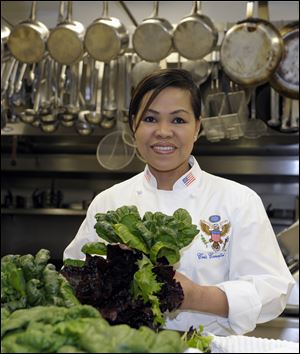
White House chef Cristeta Comerford
Certain rules must be abided for a state dinner. Second portions are never offered, but will be served if a guest requests them, she said. From the moment the first course is placed on the table to the moment the last course is served, no more than 55 minutes may elapse. And each course must absolutely be ready to be served at the proper time; no delays will be tolerated.
Though the chefs are all among the top in their field, such strict deadlines can cause the occasional problem. Mr. Mesnier remembered one near-disaster. He was making raspberry souffles, which he needed to start making 10 minutes before the guest of honor appeared. He cracked 100 eggs and began beating the whites, but the eggs did not stiffen. So he cracked 100 more and began beating them, but again they remained completely liquid.
At this point, he was getting nervous. The time to put the souffles into the oven had passed, and he had no souffles. Just then, he happened to overhear one of the savory chefs mention that they had made mayonnaise in the mixer that day. Mr. Mesnier immediately knew what had happened: Although the bowl and paddle had been cleaned, some of the oil had splashed up onto the mixer and was dripping into the egg whites. A mere three drops of oil would keep the eggs from rising. So the machine was cleaned and the eggs cracked and beaten. Mr. Mesnier put the souffles in a water bath on top of the stove to get them hot and then put them in the oven as hot as they could take it.
Miraculously, they came out on time, with no time to spare.
Frank Ruta, who worked at the White House kitchen off and on during the Reagan and first Bush presidencies, recalled that whenever the president was out of town, he tried to cook dishes that the first lady liked but that the president did not. Likewise, when the first lady was out of town, he would make food enjoyed particularly by the president.
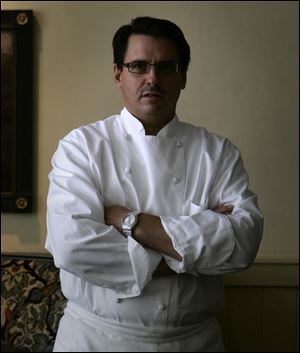
White House Chef Frank ruta
Once, when President George H.W. Bush was out of town, he made a preparation of broccoli that Barbara Bush particularly enjoyed. She asked him to make it for the president, so one day Mr. Ruta did. The president, who hated broccoli, came into the kitchen and said, "Don't ever make that again."
The chefs agreed that the presidents usually do not make extraordinary requests, except on occasion. Mr. Mesnier recalled one night before President Clinton was to leave for a trip to San Francisco. The president's daughter Chelsea was going to Stanford University at the time, in nearby Palo Alto, and he suddenly remembered it was her birthday the next day. So he called Mr. Mesnier at 10:30 p.m. to ask him to make a birthday cake by 5 a.m.
The chef went to the White House at midnight, explaining to the surprised guards that he had to work. Not only did he have to make the cake, he also had to construct a secure wooden box in which to carry it -- so he had to explain to more surprised guards that he needed the key to the carpentry shop. He made the cake, he made the box, and everything was ready to be picked up by 4:45 a.m.
"If you work for the White House, you have to be completely dedicated to the house," he said. "If you don't want to be completely dedicated, go work for someone else."
Contact Daniel Neman at dneman@theblade.com or 419-724-6155.